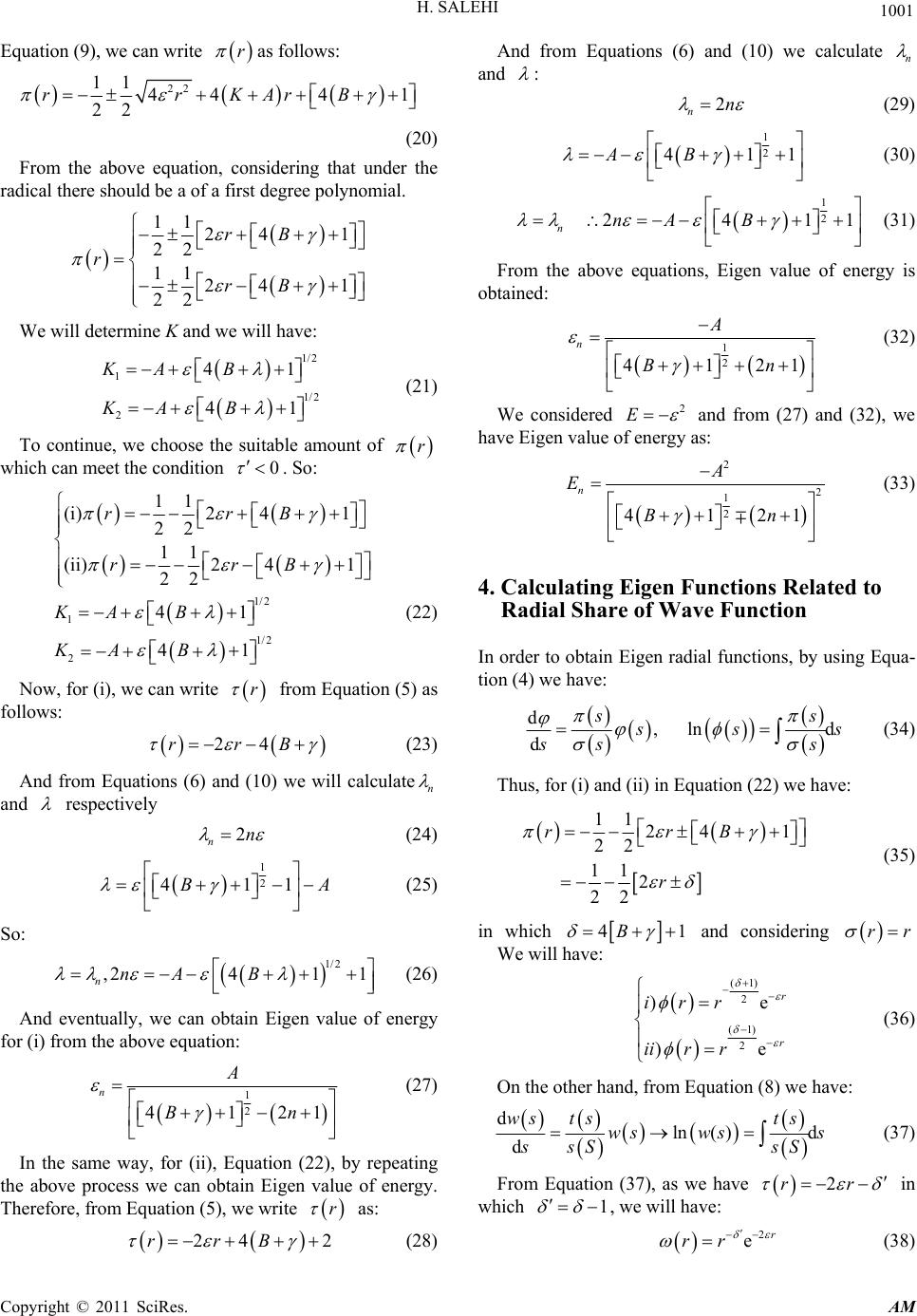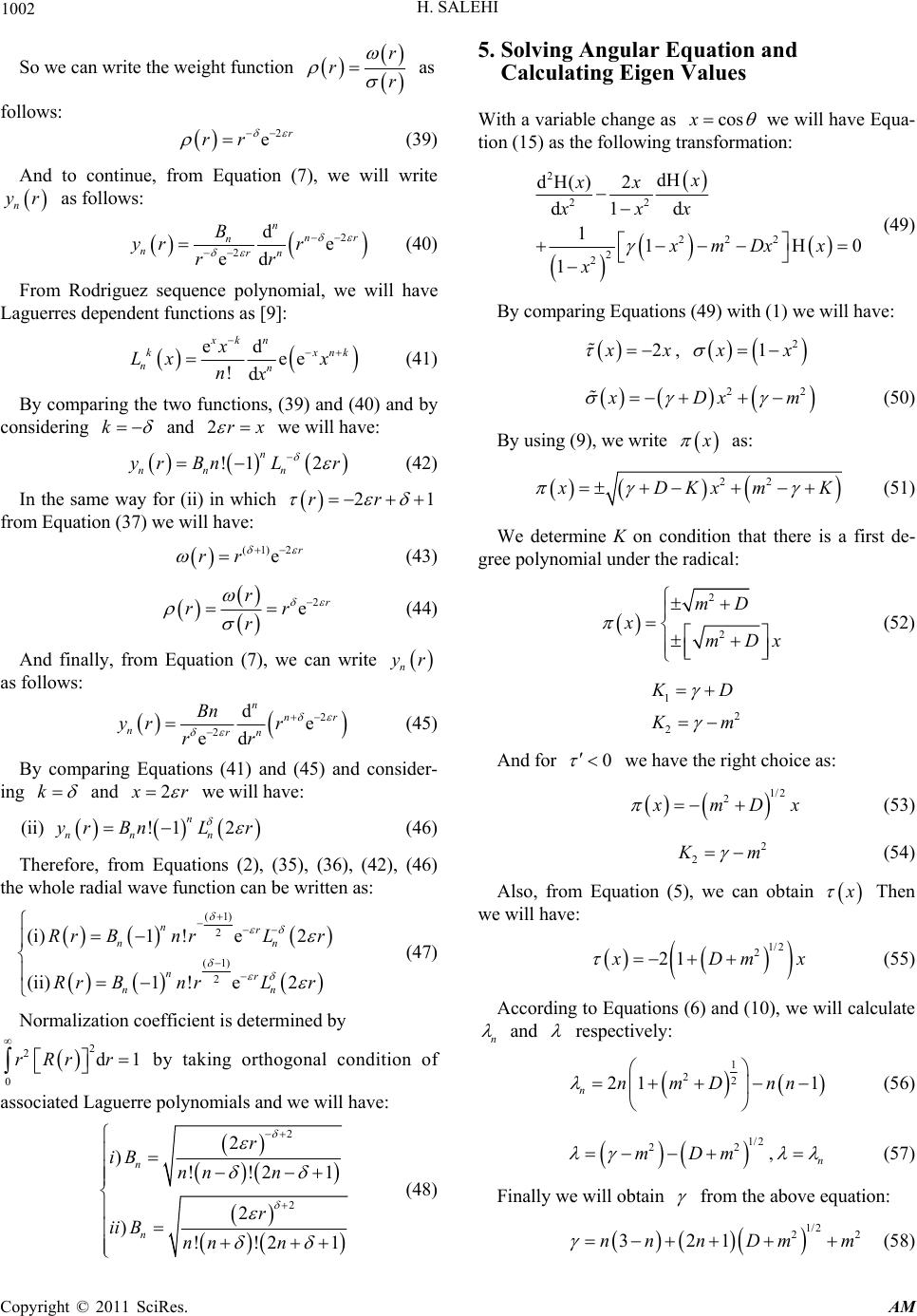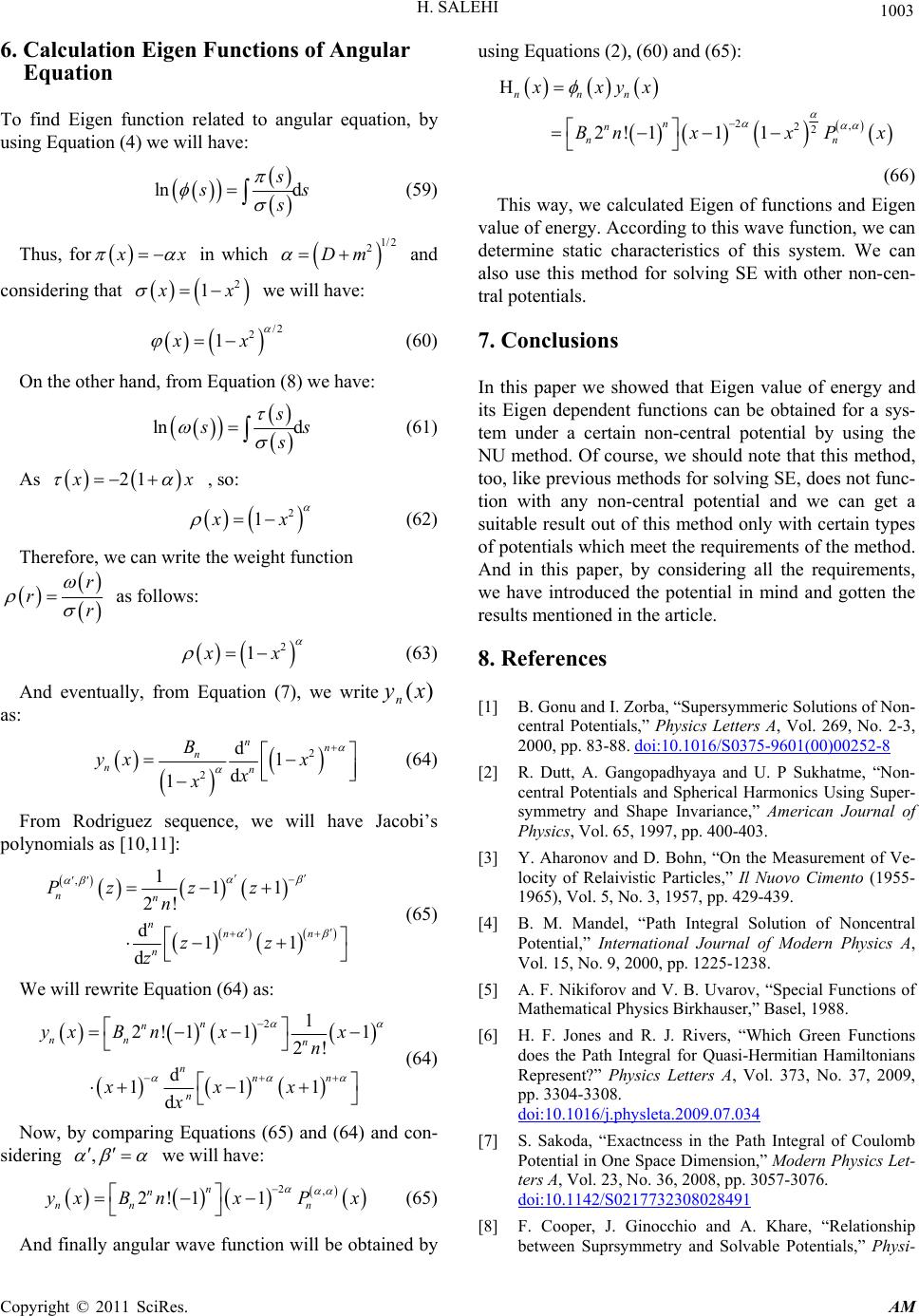 Applied Mathematics, 2011, 2, 999-1004 doi:10.4236/am.2011.28138 Published Online August 2011 (http://www.SciRP.org/journal/am) Copyright © 2011 SciRes. AM Determine the Eigen Function of Schrodinger Equation with Non-Central Potential by Using NU Method Hamdollah Salehi Department of Physi cs , Shahid Chamran University, Ahvaz, Iran E-mail: salehi_h@scu.ac.ir Received April 11, 2011; revised June 21, 2011; accepted June 28, 2011 Abstract So far, Schrodinger equation with central potential has been solved in different methods but solving this equation with non-central potentials is less dealt with. Solving such equations are way more difficult and complicated and a certain and limited number of non-central potentials can be solved. In this paper, we in- troduce one of the solvable kinds of such potentials and we will use NU method for solving Schrodinger equation and then by using this method we have calculated particular figures of its energy and function. Keywords: Schrodinger Equation (SE), Non-Central Potentials, NU Method, Central Potential 1. Introduction One of the important tasks of quantum mechanic is find- ing accurate answers of Schrodinger eq uation with a cer- tain potential. It is obvious that finding exact answers of SE by the usual and traditional methods is impossible, except certain cases such as a system with Qualeny po- tential or a coordinating oscillator. Thus, it is inevitable to use methods to help us solve this problem. Among the cases where we have to refuse ordinary methods and seek new methods is solving SE with non-central poten- tials. Such potentials are of high importance in quantum chemistry and nuclear physics. Recently, a lot of studies are being done about such potentials. Accordingly, dif- ferent methods are used to solve SE with non-central potentials among which we can name symmetrical cloud, SUSY, SIP idea [1,2], route integral [3] and Factorial method [4]. There is also another method known as NU (Niki- forov-Uvarov) which gives a clear instruction for ob- taining exact answers of certain states ,Eigen value of energy and the related functions based on Orthogonal polynomials [5]. NU method is based on reducing a sec- ond degree differential equation of SE into an equation of hyper geometric type [6-8]. Based on this, in this pa- per we will try to solve SE with a suitable potential without any limits. Therefore, we consider a potential as follows to meet all our need s in order to solve SE by NU method: 2 22 cot ,D AB Vr rrr After choosing a suitable change of variable sr, the transformed equ a tion will be as follows: 20 nn n ss ss ss s (1) In which and are polynomials of maximum second degree and is a polynomial of maximum first degree. By considering wave function n as: nnn sy s (2) Equation (1) will be redu ced to the following equation which is of hyper geometric type [5]; 0 nnn syssys ys (3) That in equations: ss (4) 2 ss ,0 (5) is a parameter which is defined as follows[5]: 1, 0,1,2, 2 n nn ns sn (6)  1000 H. SALEHI The polynomial () shows that its first derivative must be negative. We should notice that and n are obtained from a particular answer of n sys which is a polynomial of n degree. Furthermore, state- ment n s,wave function of Equation (2), is a function of hyper geometric type which is obtained from the fol- lowing Rodriguez equation [5]. d d nn n nn n yss s s (7) In which n is the normalization constant and B is a weight function which has to meet the following condition [5,6]. d d s s ss , ss (8) Function and parameter are defined as follow: 2 22 ss ss sKs (9) s (10) Since 4ac has to be a polynomial of maximum first degree, the statements under the radical in Equation (9) have to be sorted in the form of a first degree poly- nomial and this is possible when its determiner, , is zero. In this case, an equation is ob- tained for K and after solving the equation, the obtained figures for K are placed in Equation (9) and by compar- ing with Equations (6) and (10) we will calculate Eigen value of energy. 2 b 2. Schrodinger Equation with Central and Non-Central Potentials We consider time-independent SE as follows: 2 2 20 rr mEV r (11) Wave function r n elaborates certain states and their related energy levels, n, for a particle in a poten- tial field. First, central and non-central potentials E 2 22 cot ,rABD VVrrrr are considered in spiracle coordinates and put them in the above equation. () 2 2mh J 2 2 2 222 2 2 22 1 11 1 sin sin sin cot 0 r r rr r rr r ABD Er rrr (12) By considering the whole wave function as: ,,rrRr (13) And replacing in Equation (12), we can write the equation separately as follows: 22 22 dd 21 0 d d Rr RrErArBR r rr rr (14) 222 22 dd cotcot 0 d dsin mD (15) 22 2 d0 dm (16) In which m2 and 1ll are the separation fix amounts. The answer for Equation (16) is as follows [9]. 1e,0, 1, 2,, 2 im mml (17) Equations (14) and (15) are radial and angular equa- tions respectively which we are going to solve by NU method. 3. Solving Radial Equation and Calculating Eigen Values of Energy by Using NU Method For solving radial part of SE, by considering 2 EE in Equation (14) we will have: 222 22 dd 21 0 d d Rr RrrArBRr rr rr (18) Now if we compare the above equation with Equation (1), the general form of equation in NU method, we will have: 2r , rr , 22 rrArB (19) Therefore, according to the definition of r in Copyright © 2011 SciRes. AM  H. SALEHI 1001 Equation (9), we can write r as follows: 22 114441 22 rrKArB (20) From the above equation, considering that under the radical there should be a of a first degree polynomial. 11 24 24 B B 1 22 11 1 22 rB r rB We will determine K and we will have: 1/2 1 1/2 2 41 41 KA KA (21) To continue, we choose the suitable amount of r which can meet the condition 0 . So: 1/ 1/ 2 2 41 41 rr rr 2 1 2 2 11 (i)4 1 22 11 (ii)41 22 B B KA B KA B (22) Now, for (i), we can write r 24rr from Equation (5) as follows: B (23) And from Equations (6) and (10) we will calculaten and respectively 2 nn (24) 1 41 4 21BA (25) So: 1/2 ,21 1 nnA B (26) And eventually, we can obtain Eigen value of energy for (i) from the above equation: 1 2 412 nA Bn 1 2 (27) In the same way, for (ii), Equation (22), by repeating the above process we can obtain Eigen value of energy. Therefore, from Equation (5), we write as: r 24rrB (28) And from Equations (6) and (10) we calculate n and : 2 nn (29) 1 2 41AB 1 (30) n 1 2 241nA B 1 (31) From the above equations, Eigen value of energy is obtained: 1 2 412 nA Bn 1 (32) We considered 2 E and from (27) and (32), we have Eigen value of energy as: 2 2 1 2 4121 nA E Bn (33) 4. Calculating Eigen Functions Related to Radial Share of Wave Function In order to obtain Eigen radial functions, by using Equa- tion (4) we have: d, lnd d s ss ss (34) Thus, for (i) and (ii) in Equation (22) we ha ve : 11 24 1 22 11 2 22 rrB r (35) in which 4B 1 and considering rr We will have: (1) 2 (1) 2 )e )e r r irr iir r (36) On the other hand, from Equation (8) we have: dln( )d d ws tsts ws wss ssS sS (37) From Equation (37), as we have 2rr in which 1 , we will have: 2 er rr (38) Copyright © 2011 SciRes. AM  1002 H. SALEHI So we can write the weight function r rr as follows: 2 er rr (39) And to continue, from Equation (7), we will write n r as follows: 2 2 de ed nn n nrn B yr r rr r (40) From Rodriguez sequence polynomial, we will have Laguerres dependent fu nction s as [9]: ed ee !d xk n kx nn x Lx x nx nk (41) By comparing the two functions, (39) and (40) and by considering k and 2rx we will have: !1 2 n nn n yr BnLr (42) In the same way for (ii) in which from Equation (37) we will have: 21rr (1)2 er rr (43) 2 er r rr r (44) And finally, from Equation (7), we can write n r as follows: 2 2 de ed nn nrn Bn yr r rr r (45) By comparing Equations (41) and (45) and consider- ing k and 2 r we will have: (ii) !1 2 n nn n yr BnLr (46) Therefore, from Equations (2), (35), (36), (42), (46) the whole radial wave function can be written as: (1) 2 (1) 2 (i)1!e2 (ii)1 !e2 nr n nr nn Rr BnrLr Rr BnrLr n (47) Normalization coefficient is determined by 2 2 0 drRrr 1 by taking orthogonal condition of associated Laguerre polynomials and we will have: 2 2 2 )!!21 2 )!!2 n n r iB nn n r ii Bnn n 1 (48) 5. Solving Angular Equation and Calculating Eigen Values With a variable change as cosx we will tion (15) as the following transformation: have Equa- 22 2 Dx 2 22 d d() 2 d d1 1 x xx x xx 2 210 1xm x x (49) By comparing Equations (4 9) with (1) we wi ll have: 2 x , 2 1 x 22 Dx m (50) By using (9), we write as: 22 DKx mK (51) We determine K on condition that there gree polynomial under the radical: is a first de- 2 2 mD xmD x (52) 1 2 2 D m 0 And for we have the right choice as: 1/2 2 mDx (53) 2 2 m (54) m EqAlso, frouation (5), we can obtain e will hav Then we: 1/2 2 21 Dm x (55) According to Equations (6) and (10), we will calculate n and respectively: 1 22 21 1 nnmDnn (56) 1/2 22 mDm ,n (57) Finally we will obtain from the above equation: 1/2 2 321nnnDmm 2 (58) Copyright © 2011 SciRes. AM  H. SALEHI 1003 6. Calculation Eigen Functionof A Equation To fiby using Equation (4) we will have: s ngular nd Eigen function related to angular equation, ln d s (59) Thus, for x in which 1/2 2 Dm and considering that 2 1 x we will have: /2 2 1xx er hand, fr o(8) we have: (60) On the othm Equation ln d s s (61) As 21 x , so: 2 1 x (62) Therefore, we can write the weight function r rr as follows: 2 1 x it as: (63) And eventually, from Equation (7), we wre)(xyn 2 2 d1 d 1 nn n nn B yx x x x (64) acobi’sFrom Rodriguez sequence, we will have J polynomials as [10,11]: ,111 2! d11 dnzz z We will rewrite Equat nn nnn Pzz z n ion (64) as: (65) 21 2!1 11 2! d 111 d n n nn n nnn n yxBnxx n xxx ) and (64) and c sidering (64) Now, by comparing Equations (65on- , we will have: And finally angular wave function will be obtained by us 2, 2!1 1 n n nn n yxBnxPx (65) ing Equations (2), (60) and (65): ,x 222 2!111 nnn n n nn y Bnxx P This way, we calculated Eigen of functions and Eigen value of energy. According to this wave function, we can determine static characteristics of this system. We can also use this method for solving SE with other non- cen- tral potentials. 7. rtain non-central potential by using the rse, we should note that this method, ethods for solving SE, does not func- on with any non-central potential and we can get a 0375-9601(00)00252-8 xxx (66) Conclusions In this paper we showed that Eigen value of energy and its Eigen dependent functions can be obtained for a sys- tem under a ce NU method. Of cou too, like previous m ti suitable result out of this method only with certain types of potentials which meet the requirements of the method. And in this paper, by considering all the requirements, we have introduced the potential in mind and gotten the results mentioned in the article. 8. References [1] B. Gonu and I. Zorba, “Supersymmeric Solutions of Non- central Potentials,” Physics Letters A, Vol. 269, No. 2-3, 2000, pp. 83-88. doi:10.1016/S ] R. Dutt, A. Gangopadhyaya and U. P Sukhatme, “Non- als and Spherical Harmonics Using Super- Shape Invariance,” American Journal of reen Functions [2 central Potenti symmetry and Physics, Vol. 65, 1997, pp. 400-403. [3] Y. Aharonov and D. Bohn, “On the Measurement of Ve- locity of Relaivistic Particles,” Il Nuovo Cimento (1955- 1965), Vol. 5, No. 3, 1957, pp. 429-439. [4] B. M. Mandel, “Path Integral Solution of Noncentral Potential,” International Journal of Modern Physics A, Vol. 15, No. 9, 2000, pp. 1225-1238. [5] A. F. Nikiforov and V. B. Uvarov, “Special Functions of Mathematical Physics Birkhauser,” Basel, 1988. [6] H. F. Jones and R. J. Rivers, “Which G does the Path Integral for Quasi-Hermitian Hamiltonians Represent?” Physics Letters A, Vol. 373, No. 37, 2009, pp. 3304-3308. doi:10.1016/j.physleta.2009.07.034 [7] S. Sakoda, “Exactncess in the Path Integral of Coulomb Potential in One Space Dimension,” Modern Physics Let- ters A, Vol. 23, No. 36, 2008, pp. 3057-3076. doi:10.1142/S0217732308028491 [8] F. Cooper, J. Ginocchio between Suprsymmetry and Solvabl and A. Khare, “Relationship e Potentials,” Physi- Copyright © 2011 SciRes. AM  H. SALEHI Copyright © 2011 SciRes. AM 1004 cal Review D, Vol. 36, No. 8, 1987, pp. 2458-2473. doi:10.1103/PhysRevD.36.2458 [9] R. Dutt, A. Khare and U. P. Sukhatme, “Is the Order Supersymmetric WKB AppLowest roximation Exact for All Shape Invariant Potentials,” American Journal of Physics, Vol. 56, No. 2, 1988, pp. 163-168. doi:10.1119/1.15697 [10] H. Katsura, H. Aoki and J. Math, “Exact Supersymmetry in the Relativistic Hydrogen Atom in General Superchange and Ger Dimension elized Johnson-Lippman Operator,” Physics, Vol. 47, 2006, pp. 032301. [11] G. Arfken, “Mathematical Methods for Physics,” 3rd Edition, Academic Press, Waltham, 1985.
|